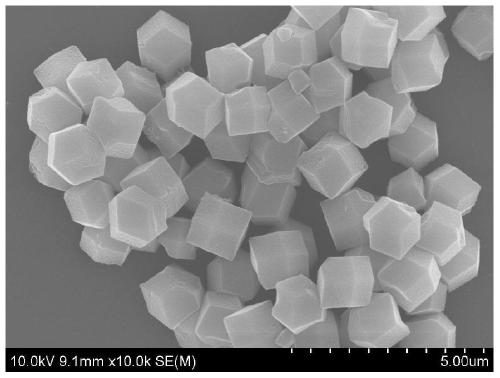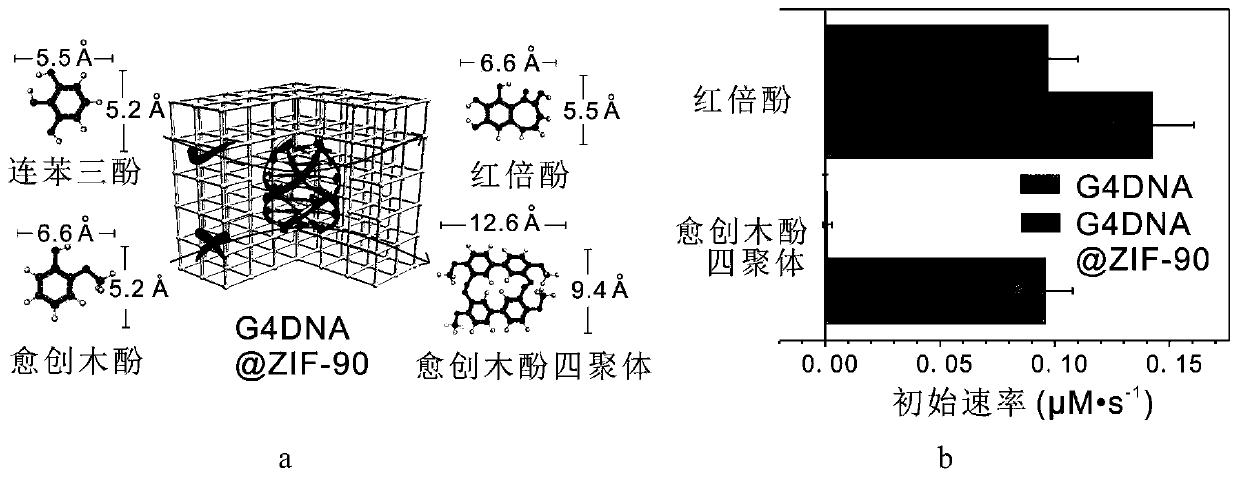DNA hybrid catalyst/MOFs composite material and preparation and application thereof
A composite material and catalyst technology, which is applied in the preparation of carbon-based compounds, organic compound/hydride/coordination complex catalysts, organic compound preparation, etc. It can solve the problems of deactivation, variability, and complicated preparation of immobilized materials. , to achieve good high temperature resistance, good resistance to organic solvents, and increase the value of recycling and reuse
- Summary
- Abstract
- Description
- Claims
- Application Information
AI Technical Summary
Problems solved by technology
Method used
Image
Examples
Embodiment 1G4
[0073] Preparation of Example 1G4DNA / MOFs composite material (G4DNA@ZIF-90)
[0074] (1) Mix the buffer of single-stranded DNA rich in guanine G with potassium chloride KCl buffer and hemin Hemin buffer to obtain the DNA hybrid catalyst G4DNA;
[0075] (2) the aqueous solution of the G4DNA that step (1) obtains, imidazole-2-formaldehyde is mixed with the aqueous solution of zinc nitrate (synthetic method reaction mechanism diagram is as follows figure 1 shown), to obtain the DNA hybrid catalyst / MOFs composite material, the SEM image of the G4DNA / MOFs composite material is shown in figure 2 shown.
Embodiment 2
[0076] Example 2G4DNA / MOFs Composite Material Size Selective Catalysis of Pyrogallol and Guaiacol
[0077] Detect the catalytic activity of the G4DNA / MOFs composite material (G4DNA@ZIF-90) prepared in Example 1 of the present invention in aqueous solution:
[0078] H 2 o 2 (1.9 mM) was added to 1 mL Tris-HCl buffer (10 mM, pH=7) containing about 4 mg G4DNA@ZIF-90 and 10 mM pyrogallol (THB) or 10 mM guaiacol to initiate the reaction. Measure the absorbance value of the supernatant product at various time points of the reaction using a UV-Vis spectrophotometer, as image 3 The initial rate diagram of the product shown in b shows that the molecular sizes of pyrogallol and guaiacol are relatively small and similar. Using pyrogallol as a substrate, the initial rate of pyrogallol to catalyzed red bisphenols by G4DNA@ZIF-90 is about It is 68% of free G4DNA catalysis; and use guaiacol as substrate and no product is observed, this is because the molecular size of the catalyzed produ...
Embodiment 3
[0079] Example 3G4 The activity of DNA / MOFs composite materials in different catalytic cycles, and the recovery of activity after soaking in different solutions
[0080]Detect the catalytic activity recovery ability of the G4DNA / MOFs composite material (G4DNA@ZIF-90) prepared in Example 1 of the present invention in aqueous solution: as Figure 4 a shows the comparison of the relative activities of G4DNA / MOFs composites for catalyzing pyrogallol (I represents the first catalytic cycle; II represents the second catalytic cycle; III represents the third catalytic cycle); after three catalytic cycles , the catalytic activity of G4DNA@ZIF-90 dropped to about 20% of the initial activity. The G4DNA@ZIF-90 particles with reduced activity were immersed in Tris-HCl buffer solution at 88 °C, and after cooling, the solids were sequentially soaked to K + and Hemin buffer solution, the activity recovery step is the same as the synthesis process of G4DNA. After treatment, G4DNA@ZIF-90 rec...
PUM
 Login to View More
Login to View More Abstract
Description
Claims
Application Information
 Login to View More
Login to View More - R&D
- Intellectual Property
- Life Sciences
- Materials
- Tech Scout
- Unparalleled Data Quality
- Higher Quality Content
- 60% Fewer Hallucinations
Browse by: Latest US Patents, China's latest patents, Technical Efficacy Thesaurus, Application Domain, Technology Topic, Popular Technical Reports.
© 2025 PatSnap. All rights reserved.Legal|Privacy policy|Modern Slavery Act Transparency Statement|Sitemap|About US| Contact US: help@patsnap.com



